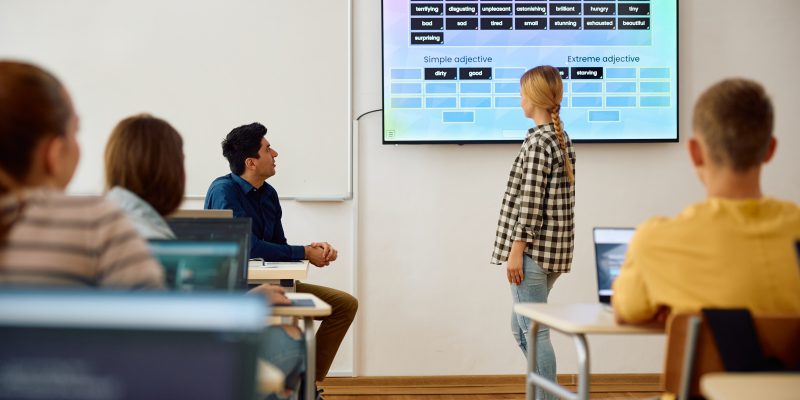Prepare your school for the digital switch-off and transition to VOIP. With an updated date of change from the UK Government (now amended to 2027), many have taken a sigh of relief with the idea that they have extra time before needing to act… We’re here to advise that you don’t fall into this trap!
Extra time has been given for a reason: it is not believed that 2025 is a realistic timeframe to get everyone moved over to VOIP (and away from copper ISDN/landlines) without issue. What does this tell us? That we should act faster, because it’s a more time-consuming process than anyone previously though.
This article whilst guiding you through the steps to ensure your school broadband and school internet are ready for the change – with a refreshing touch of IcyTea’s expertise of course!
Understanding the Digital Switch-Off
The digital switch-off marks the transition from traditional phone lines to Voice Over Internet Protocol (VOIP) systems. This change offers numerous benefits, including cost savings, improved communication, and enhanced features. However, it also requires schools to ensure their school broadband and internet are robust enough to support VOIP services.
Think of it as switching from an old kettle to a sleek, modern IcyTea brewer – the result is a more efficient and enjoyable experience. But you need to ensure that you have the right precautions and preparations managed.
Ensuring Robust School Broadband
To support VOIP, schools need reliable and high-speed school broadband. VOIP relies on internet connectivity, so any disruptions can affect communication. Schools should work with providers like IcyTea to ensure they have the necessary bandwidth and reliable connections.
Start by conducting a network audit to assess your current internet speed and reliability. Identify any areas that may need upgrades or additional support. Investing in high-quality school broadband is crucial for ensuring seamless VOIP communication.
This is one reason as to why the process of switching to VOIP has been more time consuming; the extra changes that need to be made all add to the order journey and time to transfer. If a school does not have access to fibre, for instance, then they may not have adequate speeds for VOIP, so what are schools supposed to do in this instance? Well, IcyTea works with a number of alternative network providers, meaning we have greater access to fibre networks near you. Reach out today to ask us how we can help get you connected via fibre!
Upgrading Network Infrastructure
In addition to upgrading school broadband, schools may need to enhance their network infrastructure. This includes ensuring that school Wi-Fi is robust and that there are no dead zones. A strong Wi-Fi network ensures that VOIP calls can be made from anywhere on school grounds without interruption – very useful when you might have buildings that are connected wirelessly rather than with a physical cable.
Consider adding more access points and upgrading existing hardware to support increased demand. A well-planned network infrastructure is essential for providing reliable and high-quality VOIP communication – so make sure you that you are equipped for when you switch to hosted telephony!
Implementing VOIP Systems
Once your school broadband and network infrastructure are ready, it’s time to implement the VOIP system. Choose a reliable VOIP provider that offers features tailored to educational institutions. Look for providers that offer easy integration with existing systems and provide comprehensive support. Need assistance? Let us know and we can lend a refreshing hand, taking the stress away from the experience.
Train staff on how to use the new VOIP system and highlight its features and benefits. Provide resources and support to ensure a smooth transition. It’s like introducing a new blend of IcyTea in your local café – a little guidance and a helping hand can help everyone enjoy the new experience.
Testing and Optimization
Before fully switching to VOIP, conduct thorough testing to ensure everything works seamlessly. Test calls, check sound quality, and ensure that all features are functioning correctly. Identify any issues and make necessary adjustments before you fully switch over – you want to ensure that the system works well for you, ironing out issues that could put a bad taste in users’ mouths when they finally get access to the ‘phones of the future’.
As you can imagine, at IcyTea we are strongly opposed to ‘bad tastes’, and so it is highly recommended that you focus on optimisation across your whole network – ensuring that everything is in place for your VOIP system to run smoothly. Furthermore, by staying proactive after moving over, picking up on any issues immediately as they occur, schools can ensure that their VOIP system remains reliable but also improves over time alongside your requirements.
Key Takeaways
The digital switch-off and transition to VOIP offer numerous benefits but requires careful preparation. By ensuring robust school broadband, upgrading network infrastructure, and implementing and optimising VOIP systems, schools can enjoy seamless communication for the future of their communications. So, let’s toast to the future of communication with a refreshing sip of IcyTea – here’s to smooth and efficient VOIP connections!
Do you have questions or concerns on any of the above? Let us know! We’ll happily provide support over a digital cuppa.










